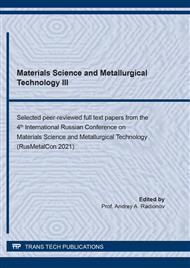p.200
p.209
p.214
p.221
p.227
p.233
p.238
p.244
p.250
Investigation of the Impurities Formation during the Silicon Melt Crystallization
Abstract:
The study of the silicon crystallization mechanism by standard analytical methods is difficult since the temperature of liquid silicon in the ladle during oxidative refining is quite high rising to 1500-1600 °C. Therefore, the method of mathematical modelling was used. To understand the mechanism of inclusions formation in silicon the authors applied a method of computer-generated state diagrams of three-component systems using the soft package Diatris. The package allows one to study the behavior of components involved in various physical and chemical transformations, and the interaction of elements with each other during the crystallization of the silicon melt. This work studies the behavior of such impurities as Fe, Ti, B, and C. To achieve the set goals, the ternary diagrams were constructed and analyzed for the Si-Ti-Fe, Si-Ti-B, Si-Ti-C, Si-Fe-B, Si-Fe-C, and Si-B-C systems. To characterize the increase in the number of crystals when a multicomponent alloy passes the crystallization interval, the crystallization rate was calculated. It is established that the most probable impurity compounds in crystalline silicon are SiFe0.4B0.06, FeTiSi5, SiB0.06Ti0.33, and SiTi0.4C0.1.
Info:
Periodical:
Pages:
227-232
Citation:
Online since:
February 2022
Authors:
Price:
Сopyright:
© 2022 Trans Tech Publications Ltd. All Rights Reserved
Share:
Citation:


